January 2010
Fri 1st: December report
Sat 9th: Wake up call
Sat 9th: A good grind
Sat 9th: The big off-centre
Sun 10th: Spoilt for choice
Sun 10th: Under attack
Wed 13th: Wing play
Wed 20th: Sorry!
Wed 28th: Short draw
Fri 1st: December report
|
|
| Turn of year tables
|
Div 1
| H C Kings
| 3
| 2
| 0
| 1
| 4
| | Newcastle A
| 3
| 2
| 0
| 1
| 4
| | Cheddleton A
| 3
| 2
| 0
| 1
| 4
| | Stafford A
| 3
| 0
| 0
| 3
| 0
|
|
|
|
Div 2
| Macclesfield
| 8
| 3
| 5
| 0
| 11
| | Alsager A
| 7
| 4
| 2
| 1
| 10
| | Meir A
| 8
| 3
| 4
| 1
| 10
| | Newcastle B
| 8
| 4
| 1
| 3
| 9
| | Cheddleton B
| 6
| 3
| 3
| 0
| 9
| | Newcastle C
| 7
| 2
| 3
| 2
| 7
| | H C Rooks
| 6
| 2
| 1
| 3
| 5
| | Stafford B
| 7
| 0
| 3
| 4
| 3
| | H C Knights
| 7
| 0
| 3
| 4
| 3
| | Fenton A
| 6
| 0
| 3
| 3
| 3
|
|
|
|
Div 3
| Cheddleton D
| 5
| 4
| 0
| 1
| 8
| | Cheddleton C
| 4
| 3
| 0
| 1
| 6
| | H C Pawns
| 5
| 1
| 2
| 2
| 4
| | Kidsgrove A
| 5
| 1
| 2
| 2
| 4
| | Fenton B
| 4
| 1
| 1
| 2
| 3
| | Alsager B
| 3
| 0
| 1
| 2
| 1
|
|
|
|
Div 4
| Newcastle D
| 5
| 3
| 1
| 1
| 7
| | Fenton C
| 4
| 3
| 1
| 0
| 7
| | Kidsgrove B
| 5
| 2
| 0
| 3
| 4
| | Cheddleton E
| 5
| 1
| 1
| 3
| 3
| | Meir B
| 5
| 1
| 1
| 3
| 3
|
|
|
|
Div 5
| Fenton D
| 6
| 5
| 1
| 0
| 11
| | Cheddleton F
| 6
| 3
| 2
| 1
| 8
| | Cheddleton H
| 5
| 2
| 1
| 2
| 5
| | Meir C
| 6
| 1
| 2
| 3
| 4
| | Newcastle E
| 6
| 1
| 2
| 3
| 4
| | Hassell
| 4
| 1
| 1
| 2
| 3
| | Cheddleton G
| 5
| 1
| 1
| 3
| 3
|
|
For whom will it be a happy new year? December is a short month for league chess, proceedings being interrupted by family and friend expecting our attentions for celebrations of some sort.
Division one has reached the halfway stage, with Stafford determined to "do better" in the second half, and the other three teams each aware that one more defeat would seriosly dent that title chances.
In Division two Alsager A have moved menacingly into joint second place behind Macclesfield, whilst Cheddleton B lead the division on a fewest points dropped calculation. With only two points separating the top five teams, it seems likely that many sides are going to finish the season within an "if only" or two of the title. Moreover with these five destined to drop points against each other it is still credible that a title challenge could emerge from the bottom half of the table.
A couple of postponed games have certainly not helped Alsager B emulate their A team - they still bring up the rear in division three, whilst a December win apiece for the Cheddleton sides have helped to consolidate their position up top.
Fenton C are now the only unbeaten team in the fourth, their win over Newcastle taking them alongside their victims. I think that Fenton have their eye firmly fixed on this title and will prove difficult to stop.
Fenton in the shape of their D team have also moved clear at the top of the fifth - will the club become known as the bullies of the bottom divisions? Or will their nomadic existence take its toll as members lose track of where their home venue currently resides?
A couple of draws have taken Newcastle E off the bottom at the same time as the squad in its D team guise lose sole leadership of the fourth, though with the teams below them having games in hand the E teams pleasure may be short-lived.
comment on this article
Sat 9th: Wake up call
Malcolm Armstrong kindly agreed to act as transport provider this weekend to enable me to participate in the Wrekin Congress, with him competing in the Open section, with me in the major. The snow caused us minimal inconvenience, and we arrived in good time for the start. Looking around there seemed to be only a small North staffs representation - apart from us I spotted Stephane Pedder and Jon and Sandra Blackburn, these three being amongst my rivals in the major where RR was one of four joint top seeds. Although Malcolm and I left on Sunday shortly after we had both finished, I think I am correct in saying hat all five of us each scored at least 50%.
My first round opponent was Neville Belinfante, this being a congress he plays rather than arbits. I have had success against him before, so definitely need to beware of complacency.
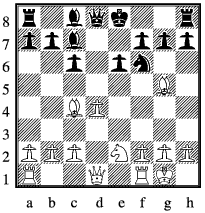
|
Neville Belinfante v RR after 10 ... Nxf6
|
After 10 moves of minor engagement culminating in an exchange of knights on f6 we reached the position shown left in which RR is behind in development. An aggressive white would continue with the advance f4, but Neville wishing to be more circumspect essayed Nf4. Right square, wrong piece.
11 Nf4 Qd6 Now the knight is pinned against mate, and Bxf6 loses a piece to Qxf4, forking bishop and mate, so Neville opted for
12 g3 Ne4, 13 Qg4 (13 Bh4 g5, 14 Qd3 f5, 15 f3 and white gains a pawn for the piece, 13 Nh3 Re1 may make black feel nervous)
13 ... Nxg5, 14 Qxg5 Qxd4, 15 Bd3 Bxf4, 16 gxf4.
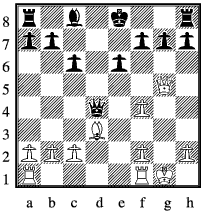
|
| Neville Belinfante v RR after 16 gxf4
|
RR is now a comfortable pawn ahead and can probably safely grab the b-pawn, though Bd7 and castles long may be more appealing to those of a nervous disposition. However RR had one of his brain storms and turned the game on its head with
16 ... Qd8, 17 Qxg7 Rf8, 18 Rad1 Qe7, 19 Qxh7 f5 with threats on the e-file and Bxh7 are surely both superior
19 ... Bd7, 20 f5 (too late) 0-0-0.
RR is a pawn down, but with a relatively safe king of his own and a white queen to harrass is in practice winning. Nevilles subsequent attempts to force the pace merely serve to hasten the end:
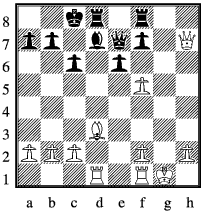
|
| Neville Belinfante v RR after 20 ... 0-0-0
|
21 fxe6 Bxe6, 22 Bxe6 with visions of material exchanges to emphasis his pawn lead
22 ... Qg5+ winning the bishop, 23 Kh1 Bxf5 now find a queen move, 24 Rg1 Rxd1 0-1
I'm on the scoreboard, but feel I've had a lucky escape.
comment on this article
Sat 9th: A good grind
Wrekin round 2, and RR gets white against Neil Homer from Northampton. After 28 moves of shadow boxing and minor threats, Neil offered some more exchanges:

|
| RR v Neil Homer after 28 ... Q(b8)f8
|
It is time to pick an endgame. I can keep the queens on with Qa5, but cannot see why I should want to force the black queen to c8. Swapping off into a same coloured bishop ending is surely a non-losing option given blacks plethora of white squared pawns, but it is not immediately apparent how I would get into his position. Consequently I elect to leave black to remove the queens (I refuse to believe that having offered the exchange he will change plans) so come up with the fairly random Kg2 - Kf2 would have been more logical, moving towards the future queenside action and allowing Qe7 to hold the kingside should black prove my beliefs wrong with Qf6.
29 Kg2 Qxb4, 30 Bxb4 h5, 31 Bd6 Kf7
32 Kf2 Ke8, 33 Be2 Nf6, 34 Ke1 g6
I have been waiting for my opponent to show his hand as relocating his knight to g6 would tie either my king or bishop down to the defence of h4, unless of course I was willing to go for the bishop ending.
35 Kd2 Bc6, 36 Bb4 Kd7, 37 Kc3 Ne8, 38 Ba5 Nd6
39 Kb4 Nb7, 40 Bb6 Kd6, 41 a4 bxa4, 42 bxa4 a5+
Black has no way of saving this pawn.
43 bxa5 Kd7, 44 Bb6 Nd6, 45 a5 Kc8, 46 Kc5 Kd7
47 a6 Nc8 Nc4 would have prolonged the struggle, though eventually his need to halt my a-pawn would allow my white squared bishop to reach e8.
47 Bb5 Nxb6, 48 Kxb6 Bxb5, 49 Kxb5 Kc7
and black resigns three moves later.
comment on this article
Sat 9th: The big off-centre
Round three, the evening match, with a substantial part of the field taking a half point bye. RR gets to be white again, against old foe Stephane Pedder. Slightly strange as that is consecutive whites for RR, and consecutive blacks for Stephane, but he elects not to query the arbiters on this.

|
| RR v Stephane Pedder after 7 d4
|
Grabbing space in the centre is a common ploy, with a big centre in which the c, d, e and f pawns are advanced being some peoples ideal. RR has a somewhat off-centre approach to the game, so goes for a big off-centre with b to e pawns advanced (see diagram). Can he survive Stephane's attempts to undermine his structure? Unfortunately I seem to have lost the score of the game, so have reconstructed it from memory. I hope that what follows is a substantially correct reconstruction
7 ... e6, 8 Be2 d6, 9 Nc3 Nc6, 10 b5 Ne7
11 0-0 c6, 12 Qb3 c5, 13 dxc5 dxc5, 14 Rfd1 Qc7
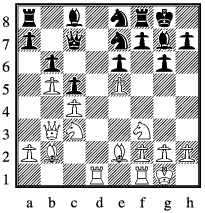
|
| RR v Stephane Pedder after 14 ... Qc7
|
I confess I'm beginning to enjoy this - must make sure I win it too!
15 Ne4 Nf5, 16 Rd3 Couldn't work out whether I wanted to play Nf6+, though Fritz says its better. However "playing by numbers" and doubling rooks on the d-file cannot be too bad can it?
16 ... h5 presumably to stop me kicking his one advanced piece with g4
17 Rfd1 Qb7, 18 Ng3 (Nfg5 releasing f3 for the bishop is stronger)
18 ... Nxg3, 19 hxg3 Qe7, 20 Nd2 Rb8 deciding that attempting to break out with a6 leads nowhere.
21 Ne4 Kh7, 22 Bf3 f6 (see diagram)
Stephane has shown an understandable reluctance to make this move; at this point it leads to the loss of the exchange.
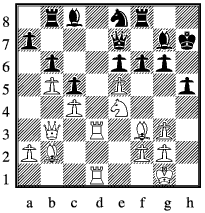
|
| RR v Stephane Pedder after 22 ... f6
|
23 exf6 Nxf6 (... Bxf6, 24 Nxf6+ Nxf6, 25 Be5)
24 Ng5+ Kh8, 25 Be5 Ng4, 26 Bxb8 Qxg5, 27 Bf4 No doubt I have time to grab the a-pawn, but I'd rather make sure that here is no chance of falling for something silly on f2.
27 ... Qf6, 28 Bxg4 hxg4, 29 Qc2 e5, 30 Rd6 Qf7
31 Bg5 Bf5, 32 Qe2 e4, 33 Rd8 Rxd8, 34 Rxd8+ Kh7
35 Bc1 Bd4, 36 Qd2 Bg7 (36 ... e3, 37 fxe3 Qf8 and either white picks up both bishops for the rook or black has to allow the rook to live)
37 Qg5 and Stephane had a Whoops Apocalypse moment with
37 ... Qxc4, 38 Qh4+
comment on this article
Sun 10th: Spoilt for choice
RR found himself starting day two of the Wrekin Congress a half-point clear of the field in the major section, with Richard Desmedt from Wombwell his next opponent, who I have played before at the Huddersfield Congress. He is a common sight on the congress circuit, the grading list showing that he played 177 graded games last year. What the grading list doesn't show is the fact that he is also one of the gentlemen on tour.
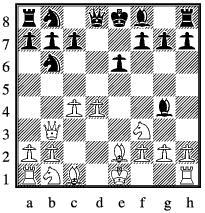
|
| Richard Desmedt v RR after 7 Qb3
|
The game has hardly started as we join it, but already some simple tactics are threatened as RR's b-pawn is vulnerable to a c-pawn advance. One way of stopping an opposition pawn move is to place a pawn of ones own on the relevant square, but I elected to tempt him to play the advance:
7 ... Nc6 8 c5 Now to see whether I'm correct that he'll regret it.
8 ... Bxf3 9 Qxf3 (Bxf3 Nxd4 10 Qd3 Nxf3+, 11 Qxf3 Bxc5 with a healthy advantage; 9 cxb6, 10 Bxe2 and white has lost a piece since Kxe2 runs into the fork Nxd4+)
9 ... Nxd4, 10 Qxb7 Nc2+, 11 Kf1
When playing Nc6 I had got as far as this in my calculations, but couldn't decide what might be the best continuation. Having reached the position over the board I still felt spoilt for choice: Qd5, Rb8, Nxa1 all seemed candidates, but I opted for
11 ... Bxc5, 12 Qc6+ Nd7, 13 Bb5 0-0, 14 Nc3 an annoying move to which I did not find the best continuation, rejecting both a6 and Nxa1 in favour of
14 ... Bb4, 15 Rb1 Nc5 and the dust was beginning to settle with RR having a pawn and some positional advantage. Over the next 40 or so moves we both struggled to find a coherent plan, so that the size of my advantage varied.

|
| Richard Desmedt v RR after 53 ... K(g7)f8
|
By the time we had completed 53 moves (diagram right) we were no longer keeping a record of the game, and I am unable to reconstruct the exact sequence of events. Suffice to say that at the end of the scramble RR found himself with K+R v K with Richards king trapped on the eighth by the rook. He resigned with my flag teetering, and his not much more stable.
comment on this article
Sun 10th: Under attack
Having had a pair of whites yesterday, I wasn't surprised to have a second Sunday black. Nor that my opponent, Francis Best from Shrewsbury elected to be aggressive as he lay a half-point behind me, and a half ahead of two players in joint third.
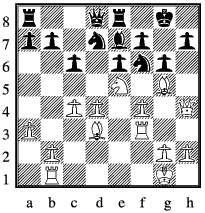
|
| Francis Best v RR after 17 Rf3
|
Seventeen moves into the game and Francis has a clear lead, with a rook coming to join four other pieces molesting my king. But a successful completion of the attack is not automatic, at least not for those who inhabit my levels of play, so I am concerned rather than despondent.
17 ... Nf8. Revealing a queen attack against d4. Interestingly the knight was destined to become an important piece.
18 Qf2 N6d7, 19 Bxe7 Qxe7, 20 Bc2 Rad8, 21 g4 Nxe5 (lacking the nerve to kich the knight with f6 - at the time it seemed too weakening, though my silicon friend says otherwise.)
22 dxe5 a6, 23 Rd3 Rxd3, 24 Bxd3 Rd8, 25 Bc2 a5 Not my proudest moment as I had not loked at Qb6 for white. Fortunately it does not do too much damage, and Francis was seduced into making a weakish move of his own:
26 c5 Rd5, 27 b4 Qd8, 28 Qf3 axb4, 29 axb4 Rd4
30 g5 Rxb4, 31 Bxg6 Qa5 (right)
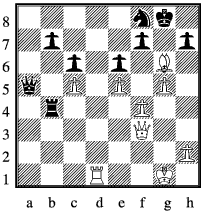
|
| Francis Best v RR after 31 ... Qa5
|
The value of the knight is now apparent. Not only does it guard against rook to the seventh and prevent sideways checks by the rook but it also guards vital squares so that sacrificial attacks starting Bxh7+/Bxf7+ lead nowhere. Reluctantly the bishop retreats.
32 Bd3 Qxc5+ and with connected passed pawns on the queenside RR makes a draw offer that Francis cannot sensibly reject. Champion.
comment on this article
Wed 13th: Wing play
Back to the league, and a match against our C team. RR has white against Alan Paling who I have played frequently in club events but not in a graded match for very many years. After 11 moves we are ready to launch attacks on opposite wings. The game seems likely to revolve around which proved to be stronger.
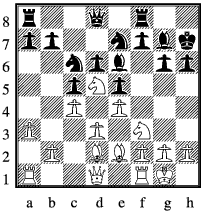
|
| RR v Alan Paling after 11 ... Kh7
|
12 b4 f5, 13 Qc1 f4 ( ... g5, 14 Bxg5 hxg5, 15 Nxg5+ with Nxe6 and a major piece fork to follow. With the f-pawn advance in the game, the f-file will remain closed for a while longer.)
14 Rb1 Nd4, 15 Nxd4 cxd4, 16 a4 Qd7, 17 b5 Rad8 Concerned about his d-pawn, and that defending it with Nc8 would cut off the a-rook.
18 f3 being concerned about the exchange sac on that square -
18 Qa3 f3, 19 Bxf3 Rxf3, 20 gxf3 and my king is somewhat exposed. Whether I should be worried is another thing entirely.
18 ... g5, 19 Qa3 Nc8, 20 Ba5 b6, 21 Bb4 Rf7 (right)
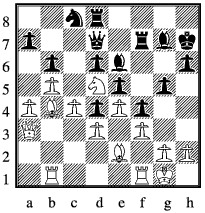
|
| RR v Alan Paling after 21 ... Rf7
|
RR is threatening to open the a-file, infiltrate with major pieces and turn right. Currently his progress seems the quicker.
22 a5 g4, 23 axb6 axb6, 24 Qa6 gxf3, 25 Bxf3 Qb7
26 Ra1 Qb8, 27 Qa8 Rb7, 28 Qxb8 Rxb8, 29 Ra6 Rd7
30 Rfa1 Rbd7, 31 Ra8 a little bit in a hurry. There is time to bring the bishop into the main arena via h5.
31 ... Rxa8, 32 Rxa8 Kg6, 33 Kf2 h5, 34 Ra6 Bh6
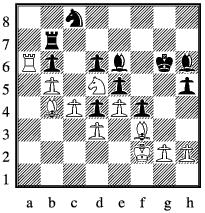
|
| RR v Alan Paling after 34 ... Bh6
|
I now start looking at giving up a piece to create passed pawns with either Bxd6 or Nxb6, but I can't see that I would have the power to push them through. An immediate c5 also seems to fail to take advantage of blacks king and bishops being on the same rank.
35 h3 Bg5, 36 Ba3 Bh4+, 37 Kf1 Bxd5 38 exd5 Be7
39 Ra8 Ra7 It is not at all apparent how to set about winning the position with the rooks off, so
40 Be4+ Kf7, 41 Rxc8 Rxa3, 42 Rb8
and I have a pawn. Despite the odd alarm over the next 20+ moves I am finally ready to shove my pawns to victory when Alan's flag falls.
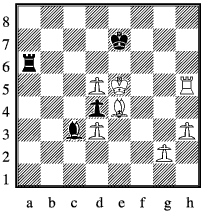
|
| RR v Alan Paling final position with black to move
|
comment on this article
Wed 20th: Sorry!
Or "What is the connection between RR and a comic strip hero?"
The weather had claimed or original fixture at Holmes Chapel Rooks a fortnight ago, but today conditions overhead and underfoot were benign, so we made the trip up the A34 and A50 to take on the Blackburn's and their henchmen.
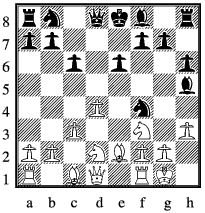
|
| Malcolm Roberts v RR after 9 ... Bh5
|
Old foe Malcolm Roberts was my immediate opponent, and after 9 moves we had reached the position left in which a couple of wasted pawn moves by RR blunted the effect of his developed pieces.
10 Ne4 Bd6 A feeble effort asking for much liquidation. Nxe2+ was surely required.
11 Nxd6+ Qxd6, 12 Bxf4 Qxf4, 13 Ne5 Bxe2, 14 Qxe2
RR has precisely nothing for his play so far whereas Malcolm is castled, fully developed, has a well placed knight and rooks free to join in without concern about defensive duties. Instead of sensibly castling or playing Nd7 for a grinding major piece middle and endgame - RR's style - he finds the horrific
14 ... Na6, 15 Nxc6 Already RR's ambition is limited to the small possibility of scrambling a draw as he has no compensation whatsoever for the pawn.
15 ... 0-0, 16 Rfe1 Rfe8 Objectively removing the knights is better, as whites is clearly better than blacks, but RR prefers to keep the material on until (hopefully) he can see a way forward.
17 Ne5 Nc7, 18 Qe4 Qxe4, 19 Rxe4
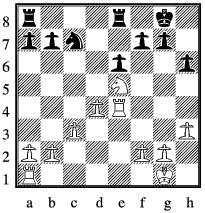
|
| Malcolm Roberts v RR after 19 Rxe4
|
Even bad plans are in short supply here (diagram right). Maybe f6 and Kf7 and just try to sit on the position and hope that somehow Malcolm's advantage dissipates. However I decided that even trying to hold the white pawns back would give Malcolm more to think about, and hence more chance of going wrong, so
19 ... b5, 20 a3 Nd5, 21 Rae1 g5 (Nb6 and Na4 merely takes the knight out of the game as the b2 pawn is easy for white to defend, Nb6 and Nc4, fares worse since after exchanging knights white continues with d5.)
22 Nd3 Kg7, 23 f4
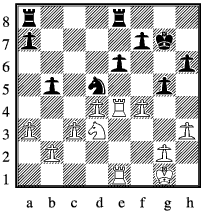
|
| Malcolm Roberts v RR after 23 f4
|
23 ... Rec8 (23 ... Nxf4, 24 Nxf4 gxf4, 25 Rxf4 f6 has something to commend it, but on deciding not to remove the f-pawn RR needs to guard against f5)
24 fxg5 hxg5, 25 Nc5 Kh6 (Kg6 saner, with Rg4 now being met by Rh8)
26 Rf1 Rg8 Deathwish. We all like to have excuses for such atrocities, and mine is that the first game had just finished and not to our advantage. No, its not much of an excuse is it?
27 Rxf7 Rg6, 28 Rxe6 Rxe6, 29 Nxe6 Re8, 30 Nc5 Small mercies
30 Rf5 Rxe6, 31 Rxd5 a6, 32 Re5 and black's rook is a bystander
30 ... Nf4, 31 Rxa7 Re1+, 32 Kf2 Re2+, 33 Kf3 Rxb2
34 h4 Nxg2, 35 hxg5+ Kh5, 36 Rh7+ Ke6, 37 Rh1
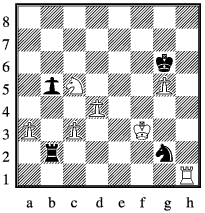
|
| Malcolm Roberts v RR after 37 Rh1
|
Should I resign? The diagram right shows that my knight and pawn have no moves, the rook is tied to its defence, and the king cannot take the g-pawn as Rg1 would then win the knight. But we are trailing ½ - 1½, and Nic on board four is down the exchange to a pawn. The team needs me to play on and find something. Anything.
37 ... Rc2, 38 Ne4 Ra2, 39 Nd6 Rb2
with visions of
40 Nxb5 Rxb5, 41 Kxg2 Rb2+, 42 Kf3 Rc2 leading to a rook endgame in which white has two isolated pawns as the c and one other pawn must drop.
40 Rg1 Nh4+, 41 Kg3 Kxg5, 42 Ne4+ Kf5, 43 Nd6+ Ke6
44 Ne4 Nf5+, 45 Kf4 Ne7, 46 Nc5+ Kd5, 47 Rg7 Nc6
48 Rd7+ Kc4, 49 Rc7 Kd5, 50 Ke3
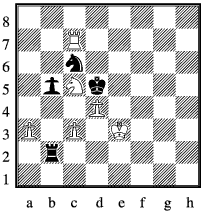
|
| Malcolm Roberts v RR after 50 Ke3
|
(Left) It looks as if the white king is headed for d3 to keep me out of c4. Meanwhile my king is rather short of squares, so
50 ... Na5, 51 Kd3 Nc4 harrass the a-pawn
52 a3 simplification
52 ... Rd2 With one bound he was free!
Nic held the draw on four, and Alex won on one. The scorecards will show that we won 3 - 2.
comment on this article
| JA (21st Jan) | You have more jam than Hartleys ;O) |
|
| RR (24th Jan) | When your brain warms up as slowly as mine a large jam factory is essential for survival. Unfortunately the workers at such factories are remarkably fickle, so one needs to take advantage whilst they are not on strike. |
|
Wed 28th: Short draw
RR is not known for quick draws, but every once in a while lack of he succumbs to the temptation for an early evening handshake. Not that this game against Julian Kirk O'Grady in the match Alsager A v Newcastle B is without some subtle interest.
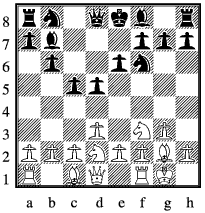
|
| Julian Kirk O'Grady v RR after 6 ... c5
|
We join the game in the asymmetrical position right after a mere 6 moves. What do you do if your opponent sets up a pawn centre? Attack it.
7 e4 A standard shove. Although the e-pawn is now attacked thrice but defended only twice it cannot be won, merely exchanged:
7 ... dxe4, 8 Ng5 and now black's pawn pinned on the long diagonal is under overwhelming attack.
8 ... Be7, 9 Ngxe4 Qd7 black has to defend against Nxf6+ followed by Bxb7 and Bxa8. Nc6 is black's main alternative at this point.
10 Nc4 deciding that attacks starting Nxf6+ and then bringing the other knight queen and queen's bishop onto the kingside was rather more show than substance. RR opts for an early release of pressure, though Nc6 and 0-0 are better designed to prolong tension and the game:
10 ... Nxe4, 11 dxe4 0-0, 12 Qxd7 Nxd7
13 Rd1 Rad8, 14 Bf4 Nf6, 15 Bc7 (diagram left)
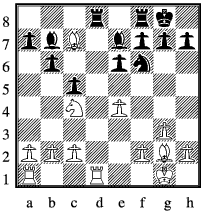
|
| Julian Kirk O'Grady v RR after 15 Bc7
|
Offering a pawn to get his rook to the seventh through the line
15 ... Rxd1+, 16 Rxd1 Bxe4, 17 Bxe4 Nxe4, 18 Rd7
Being unable to judge how much compensation white now has for the pawn, RR declined to go down this line, though with the help of unpressurised post match contemplation it would appear that black's material advantage is worth the loss of time required to unwrap his position.
15 ... Rd4, 16 Rxd4 cxd4, 17 Bd6 Bxd6
RR considered but rejected the superior Rc8. Happy to follow the potential line
17 ... Rc8, 18 Bxe7 Rxc4, 19 Bxf6 gxf6 with solid support for the d-pawn, but at the time not so sure about lines starting 18 Nxb6, though in the cold light of day it is difficult to trace the source of discomfort.
18 Nxd6 Bc6, 19 e5 Bxg2, 20 Kxg2 Ng4
21 Rd1 Nxe5, 22 Rxd4 Rd8, 23 Nb5 ½-½
I had taken a good look around the other boards before playing Rd8 as this seemed to all but force a draw. Pete had already lost on five, Nic was down two pawns for a piece and John seemed in danger of being pushed off the board by his opponents advancing pawns. Only Alex, who had an isolated d-pawn to target seemed to be bringing home the bacon. Despite the match position I chose Rd8 as other moves seemed to concede an edge in the coming endgame with little prospect of forming a plan giving myself winning chances. Julian and I left the playing room to discuss our game briefly.
During our absence the team's position improved with John getting a draw and deteriorated with Nic losing a pawn, playing on with Q and a, f and g pawns against Q, N and g and h pawns. Nic continued to frustrate his opponent with judicious sequences of checks alternating with the odd a-pawn shove until an ill-judged escape from one of these checks enabled to Nic to force the queens off leaving his passed pawn uncatchable. Meanwhile Alex' technique was up to the job, winning a couple of pawns and then the game. With the dust settling a totalling of the scores showed us to be 3 - 2 winners.
comment on this article






















